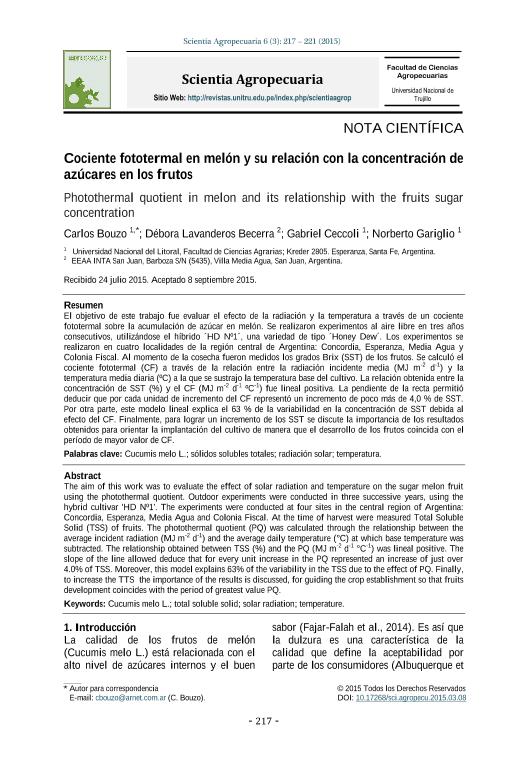Mostrar el registro sencillo del ítem
dc.contributor.author
Bouzo, Carlos Alberto

dc.contributor.author
Lavanderos Becerra, Débora
dc.contributor.author
Céccoli, Gabriel

dc.contributor.author
Gariglio, Norberto Francisco

dc.date.available
2018-06-22T21:31:47Z
dc.date.issued
2015-09
dc.identifier.citation
Bouzo, Carlos Alberto; Lavanderos Becerra, Débora; Céccoli, Gabriel; Gariglio, Norberto Francisco; Cociente fototermal en melón y su relación con la concentración de azúcares en los frutos; Universidad Nacional de Trujillo. Facultad de Ciencias Agropecuarias; Scientia Agropecuaria; 6; 3; 9-2015; 217-221
dc.identifier.issn
2077-9917
dc.identifier.uri
http://hdl.handle.net/11336/49818
dc.description.abstract
El objetivo de este trabajo fue evaluar el efecto de la radiación y la temperatura a través de un cociente fototermal sobre la acumulación de azúcar en melón. Se realizaron experimentos al aire libre en tres años consecutivos, utilizándose el híbrido ´HD Nº1´, una variedad de tipo ´Honey Dew´. Los experimentos se realizaron en cuatro localidades de la región central de Argentina: Concordia, Esperanza, Media Agua y Colonia Fiscal. Al momento de la cosecha fueron medidos los grados Brix (SST) de los frutos. Se calculó el cociente fototermal (CF) a través de la relación entre la radiación incidente media (MJ m-2 d-1) y la temperatura media diaria (ºC) a la que se sustrajo la temperatura base del cultivo. La relación obtenida entre la concentración de SST (%) y el CF (MJ m-2 d-1 ºC-1) fue lineal positiva. La pendiente de la recta permitió deducir que por cada unidad de incremento del CF representó un incremento de poco más de 4,0 % de SST. Por otra parte, este modelo lineal explica el 63 % de la variabilidad en la concentración de SST debida al efecto del CF. Finalmente, para lograr un incremento de los SST se discute la importancia de los resultados obtenidos para orientar la implantación del cultivo de manera que el desarrollo de los frutos coincida con el período de mayor valor de CF.
dc.description.abstract
The aim of this work was to evaluate the effect of solar radiation and temperature on the sugar melon fruit using the photothermal quotient. Outdoor experiments were conducted in three successive years, using the hybrid cultivar 'HD Nº1'. The experiments were conducted at four sites in the central region of Argentina: Concordia, Esperanza, Media Agua and Colonia Fiscal. At the time of harvest were measured Total Soluble Solid (TSS) of fruits. The photothermal quotient (PQ) was calculated through the relationship between the average incident radiation (MJ m-2 d -1 ) and the average daily temperature (°C) at which base temperature was subtracted. The relationship obtained between TSS (%) and the PQ (MJ m-2 d -1 °C-1 ) was lineal positive. The slope of the line allowed deduce that for every unit increase in the PQ represented an increase of just over 4.0% of TSS. Moreover, this model explains 63% of the variability in the TSS due to the effect of PQ. Finally, to increase the TTS the importance of the results is discussed, for guiding the crop establishment so that fruits development coincides with the period of greatest value PQ.
dc.format
application/pdf
dc.language.iso
spa
dc.publisher
Universidad Nacional de Trujillo. Facultad de Ciencias Agropecuarias
dc.rights
info:eu-repo/semantics/openAccess
dc.rights.uri
https://creativecommons.org/licenses/by-nc-sa/2.5/ar/
dc.subject
Cucumis Melo L.
dc.subject
Sólidos Solubles Totales
dc.subject
Radiación Solar
dc.subject
Temperatura
dc.subject.classification
Otras Agricultura, Silvicultura y Pesca

dc.subject.classification
Agricultura, Silvicultura y Pesca

dc.subject.classification
CIENCIAS AGRÍCOLAS

dc.title
Cociente fototermal en melón y su relación con la concentración de azúcares en los frutos
dc.title
Photothermal quotient in melon and its relationship with the fruits sugar concentration
dc.type
info:eu-repo/semantics/article
dc.type
info:ar-repo/semantics/artículo
dc.type
info:eu-repo/semantics/publishedVersion
dc.date.updated
2018-05-07T18:02:48Z
dc.identifier.eissn
2306-6741
dc.journal.volume
6
dc.journal.number
3
dc.journal.pagination
217-221
dc.journal.pais
Perú

dc.journal.ciudad
Trujillo
dc.description.fil
Fil: Bouzo, Carlos Alberto. Universidad Nacional del Litoral. Facultad de Ciencias Agrarias. Departamento de Producción Vegetal. Cátedra de Cultivos Intensivos; Argentina
dc.description.fil
Fil: Lavanderos Becerra, Débora. Instituto Nacional de Tecnología Agropecuaria. Centro Regional Santa Fe; Argentina
dc.description.fil
Fil: Céccoli, Gabriel. Universidad Nacional del Litoral. Facultad de Ciencias Agrarias. Cátedra de Morfología Vegetal; Argentina. Consejo Nacional de Investigaciones Científicas y Técnicas. Centro Científico Tecnológico Conicet - Santa Fe; Argentina
dc.description.fil
Fil: Gariglio, Norberto Francisco. Universidad Nacional del Litoral. Facultad de Ciencias Agrarias. Departamento de Producción Vegetal. Cátedra de Cultivos Intensivos; Argentina
dc.journal.title
Scientia Agropecuaria
dc.relation.alternativeid
info:eu-repo/semantics/altIdentifier/doi/http://dx.doi.org/10.17268/sci.agropecu.2015.03.08
dc.relation.alternativeid
info:eu-repo/semantics/altIdentifier/url/http://www.revistas.unitru.edu.pe/index.php/scientiaagrop/article/view/960
Archivos asociados
